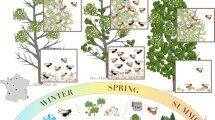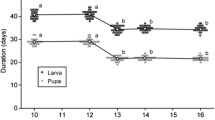Abstract
The frond-feeding weevil, Stenopelmus rufinasus Gyllenhal, was imported into quarantine for testing as a potential natural enemy for the invasive fern Azolla filiculoides Lamarck in South Africa. Adult S. rufinasus lived for approximately 55 days during which the females produced on average 325 offspring. The developmental period for the immature stages (egg, three larval instars and pupation) was about 20 days indicating the potential for several overlapping generations per year. Both the adults and the larvae caused severe damage to A. filiculoides in the laboratory. Host specificity of this insect was determined by adult no-choice oviposition and larval starvation tests on 31 plant species in 19 families. Adult feeding, oviposition and larval development was only recorded on the Azolla species tested (A. filiculoides, A. pinnata subsp. poss. asiatica R.K.M. Saunders and K. Fowler, A. pinnata subsp. africana (Desv.) R.K.M. Saunders and K. Fowler and A. nilotica De Caisne Ex Mett.). A. filiculoides proved to be significantly the most suitable host for the weevil. The low adult emergence from A. nilotica and A. pinnata subsp. africana would most probably prevent the weevil from establishing on them in the field. A. pinnata subsp. poss. asiatica which supported greater development, is thought to be introduced and has a weedy phenology in South Africa and is thus of low conservation value. Therefore, any damage inflicted on this plant in the field may be an acceptable trade-off for the predicted impact of S. rufinasus on the aggressive exotic weed, A. filiculoides.
Similar content being viewed by others
References
Ashton, P.J., 1974. The effect of some environmental factors on the growth of Azolla filiculoidesLam. In: E.M. van Zinderen-Bakker Sr. (ed), Orange River progress report. Institute for Environmental Sciences, University of the Orange Free State, Bloemfontein, South Africa. pp. 123-138.
Ashton, P.J., 1978. Factors affecting the growth and development of Azolla filiculoidesLam. Proceedings of the Second National Weeds Conference of South Africa, Stellenbosch University, 1977. pp. 249-268.
Ashton, P.J. and R.D. Walmsley, 1976. The aquatic fern Azollaand its Anabaenasymbiont. Endeavour35: 39-43.
Ashton, P.J. and R.D. Walmsley, 1984. The taxonomy and distribution of Azollaspecies in southern Africa. Botanical Journal of the Linnaean Society89: 239-247.
Bedel, L., 1901. Description et moeurs d'un nouvea genre de Curculionides de France. Bull. Soc. Entomol. France6: 358-359.
Buckingham, G.R. and M. Buckingham, 1981. A laboratory biology of Pseudolampsis guttata(LeConte) (Coleoptera: Chrysomelidae) on waterfern, Azolla carolinianaWilld. (Pteridophyta: Azollaceae). The Coleopterists Bulletin35: 181-188.
Center, T.D., G. Jubinsky and F.A. Dray, 1992. Insects that feed on aquatic plants: biology and identification manual. Agricultural Research Service - United States Department of Agriculture, Fort Lauderdale, USA. 94 pp.
Costa Lima, A.M., 1968. Quarto Catálogo dos Insetos que Vivem nas Plantas do Brasil seus parasitos e predatores. Parte 2 - 2 tomo, Índica de insetos e índice de plantas. Ministério do Agricultura, Departmento de Defesa e Inspeção Agropecuaria, Rio de Janero, Brasil. 265 pp.
Gomez, L.D., 1978. Some insect interactions with Azolla mexicana. Proceedings of the Entomological Society of Washington24: 125-126.
Gyllenhal, L., 1936. Stenopelmus rufinasus. In: C. Schoenherr (ed), Genera et Species Curculionidum, cum synonymia hujus Familiae: Species Novae aut Hactenus Minus Cognitae, Descriptionibus a Dom. Leonardo Gyllenhal, C.H. Boheman, et Entomologis Aliis, Illustratae. Vol. 3(1): 469. Publisher Roret, Paris.
Habeck, D.H., 1979. Host plants of Pseudolampsis guttata(LeConte (Coleoptera: Chrysomelidae)). The Coleopterists Bulletin33: 150.
Harris, P. and H. Zwölfer, 1968. Screening of phytophagous insects for biological control of weeds. Canadian Entomologist100: 295-303.
Hayward, K.J., 1958. Insectos Tucumanos Prejudiciales. Revista Industrial y Agrícola deTucuman, Tomo 42, Publicacion de la Estación Experimental Agrícola de la Provincia deTucuman, Argentina.
Hill, M.P., 1997. The potential for the biological control of the floating aquatic fern, Azolla filiculoidesLamarck (red water fern/rooivaring) in South Africa. Water Research Commission Report No. K.V. 100/97 ISBN 1 86845 280 8. 31 pp.
Jacot Guillarmod, A., 1979. Water weeds in southern Africa. Aquatic Botany6: 377-391.
Janson, O.E., 1921. Stenopelmus rufinasusGyll., an addition to the list of British Coleoptera. Entomologist's Monthly Magazine57: 225-226.
LeConte, J.L., 1876. The Rhynchophora of America, North of Mexico. Proceedings of the American Philosophical Society15: 160-180.
Lumpkin, T.A. and D.L. Plucknett, 1982. Azolla as a green manure: use and management in crop production.Westview Tropical Agriculture Series No. 5. Westview Press, Boulder, Colorado. 230 pp.
Oosthuizen, G.J. and M.M. Walters, 1961. Control of water fern with diesoline. Farming in South Africa37: 35-37.
Richerson, P.J. and A.A. Grigarick, 1967. The life history of Stenopelmus rufinasus(Coleoptera: Curculionidae). Annals of the Entomological Society of America60: 351- 354.
Schelpe, E.A.C.L.E. and N.C. Anthony, 1986. Flora of southern Africa: Pteridophyta. Dept. of Agriculture and Water Supply, Pretoria, South Africa. 292 pp.
Wapshere, A.J., 1974. A strategy for evaluating the safety of organisms for biological weed control. Ann. Appl. Biol.77: 201-211.
Wapshere, A.J., 1989. A testing sequence for reducing rejection of potential biological control agents for weeds. Ann. Appl. Biol.114: 515-526.
Zar, J.H. 1974. Biostatistical analyses. Prentice-Hall Inc., New York. 620 pp.
Zwölfer, H. and P. Harris, 1971. Host specificity determination of insects for biological control of weeds. Ann. Rev. Entomol.16: 159-178.
Author information
Authors and Affiliations
Rights and permissions
About this article
Cite this article
Hill, M. Life history and laboratory host range of Stenopelmus rufinasus, a natural enemy for Azolla filiculoides in South Africa. BioControl 43, 215–224 (1998). https://doi.org/10.1023/A:1009903704275
Issue Date:
DOI: https://doi.org/10.1023/A:1009903704275




